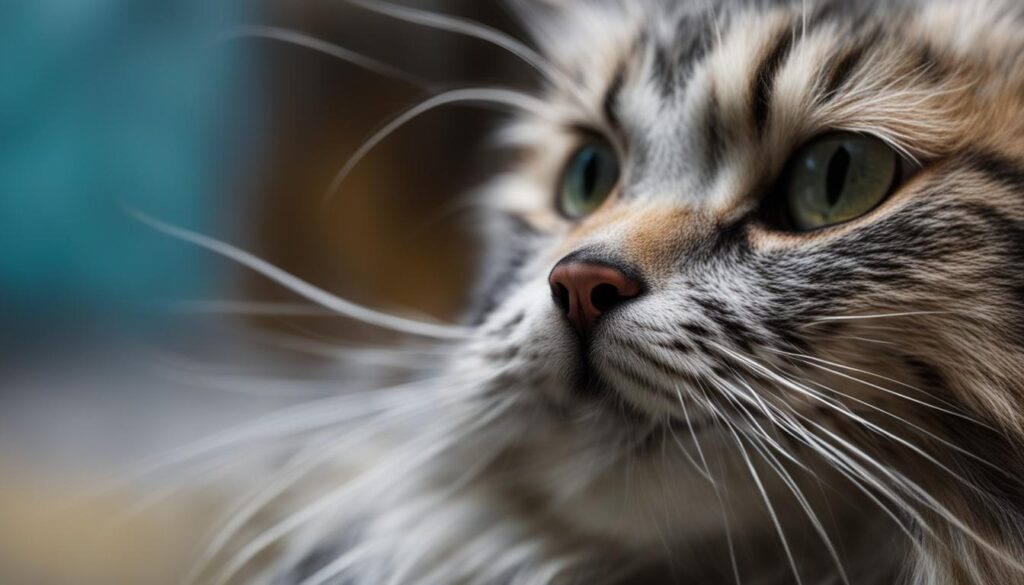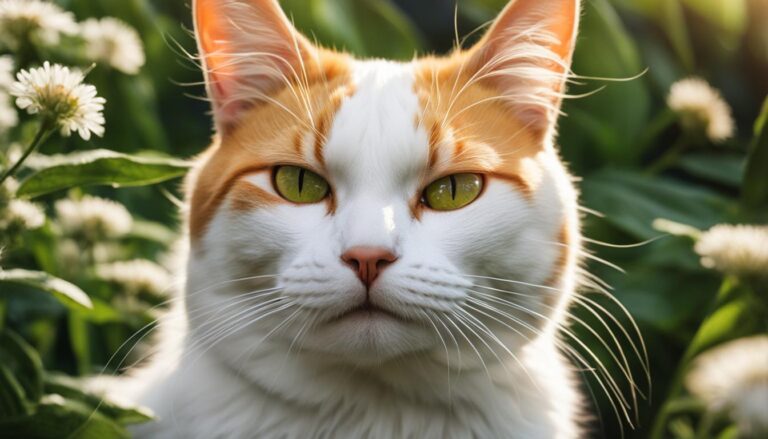Have you ever wondered if cats can catch colds, just like humans? Well, the answer is yes! Cats can indeed get colds, also known as upper respiratory infections (URI). Just like us, they can experience symptoms such as sneezing, sniffles, watery eyes, and a runny nose. So, if you’ve noticed your feline friend displaying these signs, it’s important to understand what causes cat colds and how you can care for them.
Punti di forza:
- Cats can get colds, known as upper respiratory infections (URI).
- Symptoms include sneezing, sniffles, watery eyes, and a runny nose.
- Cats in outdoor or crowded environments are more susceptible to colds.
- Viral and bacterial infections can cause cat colds.
- Monitoring symptoms and seeking veterinary care is important for your cat’s health.
Causes of Cat Colds
Cat colds, also known as upper respiratory infections (URI), can be caused by various factors. The most common culprits behind cat colds are viral infections, particularly feline viral rhinotracheitis (FVR). FVR is highly contagious among cats and is a leading cause of upper respiratory infections in feline populations. Other viral causes include feline calicivirus and Chlamydophila felis. These viruses can easily spread through direct contact with an infected cat or through contaminated objects.
In addition to viruses, bacteria can also lead to cat colds. Bordetella bronchiseptica and various species of Mycoplasma are common bacterial causes of respiratory infections in cats. These bacteria can be contracted through close proximity to infected cats or through contaminated environments.
It is important to note that some cats may be more susceptible to developing colds due to their age, overall health, or exposure to stressful or crowded environments. Cats with weakened immune systems are also at higher risk.
To reduce the risk of your cat contracting a cold, it is crucial to ensure they are up-to-date on their vaccinations. Regular veterinary check-ups and maintaining a clean and stress-free environment for your cat can also help prevent the occurrence of cat colds.
| Cause | Descrizione |
|---|---|
| Feline viral rhinotracheitis (FVR) | A highly contagious viral infection that affects the respiratory system of cats, leading to cold-like symptoms. |
| Feline calicivirus | Another common viral cause of cat colds, known for causing oral ulcers and joint pain in addition to respiratory symptoms. |
| Chlamydophila felis | A bacterium that can cause respiratory infections in cats, often transmitted through direct contact or contaminated environments. |
| Bordetella bronchiseptica | A bacterial species that can cause respiratory infections in cats, commonly transmitted through close contact with infected cats. |
| Mycoplasma species | Various species of bacteria that can cause respiratory infections in cats, often transmitted through close contact with infected cats. |
Symptoms of Cat Colds
If you suspect that your cat may have a cold, it’s important to be aware of the common symptoms. Monitoring these signs will help you determine if your cat needs veterinary care or if it’s a mild case that can be managed at home.
The most noticeable symptom of a cat cold is sneezing. If you notice your cat frequently sneezing, it could be a sign of an upper respiratory infection. Another common symptom is congestion, which can cause your cat’s breathing to sound labored or noisy. You may also observe your cat having watery eyes and a runny nose, similar to humans with a cold. In some cases, cats with colds may experience a mild fever, but it usually subsides quickly.
In more severe cases, cats may exhibit reduced appetite and coughing. These symptoms may indicate a more complicated infection or secondary issues like pneumonia. If your cat shows persistent or worsening symptoms, it’s important to consult a veterinarian for a proper diagnosis and treatment plan.
Common Symptoms of Cat Colds:
- Sneezing
- Congestion
- Watery eyes
- Runny nose
- Mild fever
Remember, it’s crucial to watch for any changes in your cat’s behavior or health and seek veterinary attention if necessary. Early intervention can prevent complications and ensure a swift recovery for your furry friend.
| Symptoms | Mild Cold | Severe Infection |
|---|---|---|
| Sneezing | Occasional | Frequent |
| Congestion | Mild | Labored breathing |
| Watery eyes | Sì | Sì |
| Runny nose | Sì | Sì |
| Mild fever | Sì | Sì |
| Reduced appetite | No | Sì |
| Coughing | No | Sì |
Caring for a Cat with a Cold
If your cat is feeling under the weather and has caught a cold, there are several ways you can provide care and comfort to help them recover. Here are some simple steps you can take:
Keep your cat’s nose and eyes clean
- Gently wipe your cat’s runny nose and eyes with a clean cloth dampened with a saline solution. This will help remove any discharge and keep their nasal passages clear.
Create a humid environment
Running a humidifier in the room where your cat spends most of their time can help alleviate dry air and make breathing easier for them. This can help soothe congestion and reduce coughing.
Use steam to ease congestion
If your cat is congested, you can create a steam tent to help clear their airways. Place your cat in their pet carrier and position a bowl of hot water in front of the cage. Cover the carrier and bowl with a blanket, allowing your cat to inhale the steam for about 15 minutes. This can help ease their breathing and provide relief.
Encourage eating and drinking
It’s important to ensure that your cat continues to eat and drink while they have a cold. Warm up their food slightly to make it more appealing and easier to swallow. You can also try offering wet food or adding some warm water to their kibble to increase moisture intake. Make sure your cat has access to fresh water at all times.
Additionally, provide your cat with a warm and cozy environment by adding an extra blanket to their bed or favorite resting spot. This will help keep them comfortable and promote relaxation, which is essential for their recovery.

Remember, while cat colds are usually harmless and resolve within a couple of weeks, it’s important to monitor your cat’s symptoms. If there is no improvement after a few days or if their condition worsens, it’s best to consult a veterinarian for further evaluation and treatment.
Conclusione
In most cases, cat colds are harmless and will resolve within 1-2 weeks. However, it is essential to monitor your cat’s health and seek veterinary care if there is no improvement after a few days or if more severe symptoms develop. Cats that are older, kittens, or have underlying health conditions may be more susceptible to complications from a cold, such as pneumonia.
As a responsible pet owner, it is crucial to prioritize your cat’s health and well-being. Regular vet check-ups, vaccinations, and maintaining a clean and stress-free environment can help prevent colds and other illnesses in cats.
Remember, your furry friend relies on you to provide the best care possible. By being attentive to their health, giving them the necessary attention when they are unwell, and taking preventative measures, you can keep your cat healthy and happy. If you have any concerns about your cat’s health, don’t hesitate to consult your veterinarian for professional advice.




